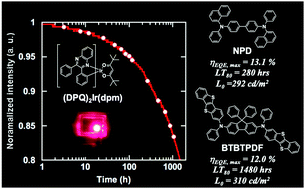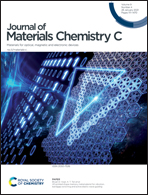Improved operational lifetime of deep-red phosphorescent organic light-emitting diodes using a benzothienobenzothiophene (BTBT)-based p-type host material†
Abstract
Although deep-red organic light-emitting diodes (OLEDs) with emission peak wavelengths beyond 660 nm are attractive candidates as unique light sources for plant growth or health-monitoring systems, the research on these OLEDs is not advanced over those emitting in other visible spectral regions. Here, we demonstrate a highly efficient and very stable deep-red OLED based on a novel exciplex host system. The developed system achieves an external quantum efficiency of 12% and shows a long lifetime of nearly 1500 h at an initial luminance of approximately 300 cd cm−2 (current density: 25 mA cm−2). These are the best performance parameters reported so far in the scientific literature for a deep-red OLED. Additionally, the effect of the p-type exciplex host material on the device performance is investigated. A device based on the benzothienobenzothiophene (BTBT)-based p-type host material with superior electrochemical and thermal stabilities provides higher efficiency and more than five times longer stability than that based on the conventional p-type host material, NPD.



 Please wait while we load your content...
Please wait while we load your content...